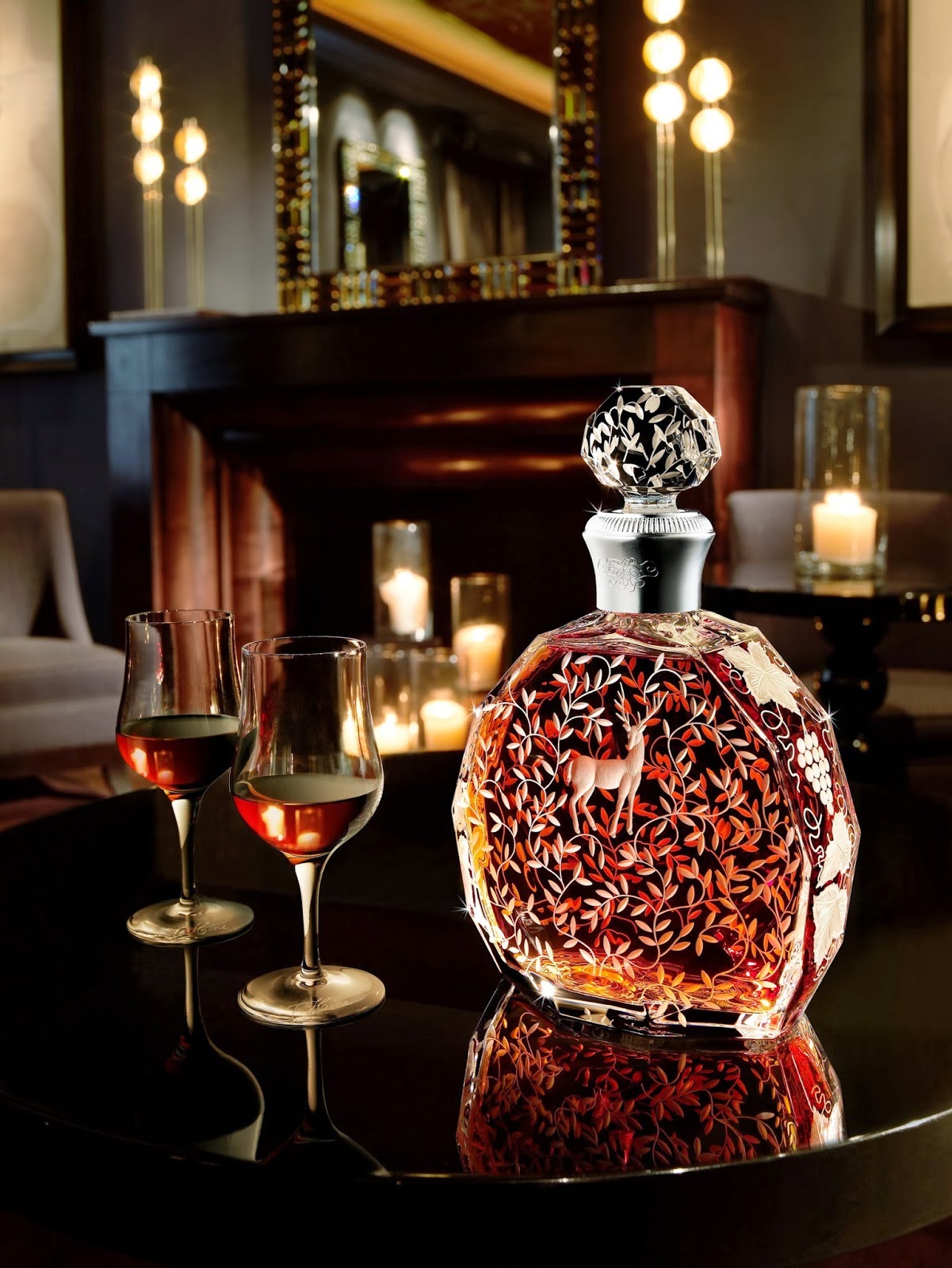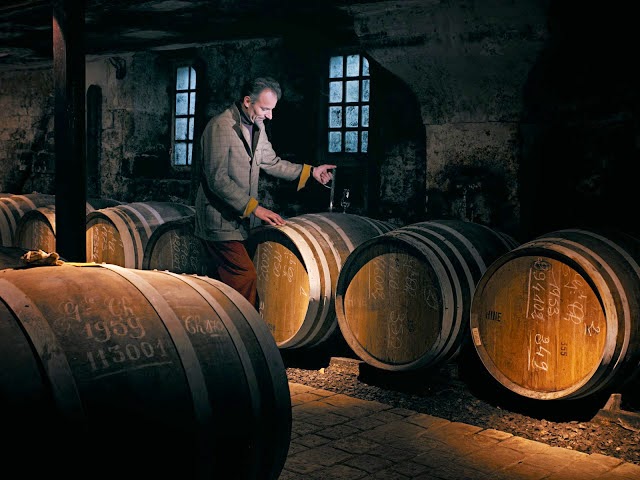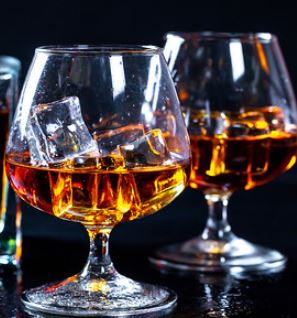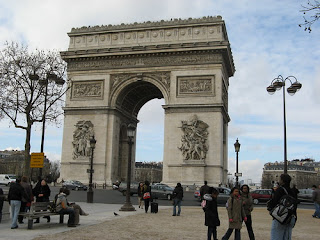Martell
V.S.O.P. and a Cognac snifter.
Why you cannot age Cognac at home
Cognac and other liquors, unlike wines, only mature in a barrel; once bottled your Cognac, Armagnac, Calvados and also your whisky or whiskey, will age no more.
That bottle of a six-year-old Cognac bought twenty years ago, and just rediscovered in the back of a dark cupboard, is only as good, maybe, as it was on the day it was bottled. It is not a Cognac that has matured for twenty–six years! Luckily, many Cognacs, in old bottles, are valuable for the rarity of the bottle and the label.
Storing Cognac at home
Cognac and other liquors must be stored standing up; otherwise, the alcohol will attack the cork. If the cork, of an old Cognac, has deteriorated over time and some of the Cognac has evaporated then the taste of the Cognac that is left will be different; however, that is not aging, it is the results of evaporation and a dried out cork will hardly have provided any improvement.
II wouldn’t
advise drinking anything in these bottles.
The
value is in the label and bottle, not the contents.
www.flickr.com/photos/la_bretagne_a_paris/15014877515/
Caveat Emptor: When you see a one-hundred-year-old Cognac or an even older Cognac, offered for sale, you are, no doubt, being offered a Cognac that was bottled one-hundred or more years ago. None of these bottles will contain Cognacs or eau-de-vies that were aged in barrels for one hundred plus years, that cannot happen, they would be undrinkable. If a really old bottle does contain any Cognac it was probably in a barrel for less than ten years and then was bottled, and that Cognac will remain a ten-year-old Cognac one hundred years later. On the upside, the bottle and label may be truly unique. For more information about the legal ages and grades on Cognac labels read the post: Deciphering Cognac Labels and How to Tell the Age and Grade of a Cognac. Cognac I.
The meaning of eau-de-vie.
A young eau-de-vie, in the world of Cognac, is a young liquor not yet a brandy; these eau-de-vies, as they age they will become simple brandies; though not very drinkable ones; however, when the aging is complete and blended with others they will become a complete and truly unique grape brandy, a Cognac.
Decanting Cognacs.
The old British tradition of decanting Cognacs to a beautiful decanter can bring smiles all around and warm the atmosphere even before the first sip. Cognac in a decanter will remain, more or less, the same as it was when first decanted for up to a year. The more often that the decanter is opened evaporation will begin to show its effect just as will a bottle that is open and closed; however, from personal experience that is rarely a problem; decanted Cognac always seems to be finished within four or five weeks.
Hine
Cognac Talent arrives in a cut-glass decanter.
Photograph courtesy of Gilles de Beauchêne from Hine
Cognac.
Cognac begins with white wine.
All Cognacs start with white wine grapes gathered, pressed and made into wine. The wines that create Cognac are extremely important; however, these wines are never used as table wines.
The names of the grapes used will not be on the labels of most Cognac bottles though they will undoubtedly affect the taste. The most popular grape in the Cognac region is the ugni blanc grape, locally called the St.-Émilion, but eight other grape varieties may be used, and they all bring different tastes to the final brandy.
Grapes ready for
picking.
www.flickr.com/photos/fruitnet/2397935531/
The new wines used to make Cognac eau-de-vies are not aged as within a few months of becoming wine they will have been distilled twice, and have become fledgling eau-de-vies, young liquors.
The oak barrels used for Cognac eau-de-vies.
The oaks chosen for Cognac’s barrels come from the Limousin and Troncais oaks; these particular oaks have been evaluated over hundreds of years, and no other oak has been found to be better.
The
smallest Cognac barrels.
www.flickr.com/photos/dunleavy_family/9467244674/
Cognac experts will explain that the barrels made from these oaks affect the aroma, taste, and colors of Cognac in ways that no other oak can replicate. The larger the barrel the higher the exposure of the eau-de-vie to the wood; the wood provides critical contributions to taste, aroma and color; however, the larger the barrel, the greater the evaporation. Barrels sizes are from 200 liters to over 400 liters with the most typical barrel size being 300 liters. The color of a cognac and many of its flavors will come from the wood on the inside of charred oak barrels
In the
Tonnellerie,
Where
the barrels are made.
Photograph
by Gilles de Beauchêne courtesy of Hine Cognac
What goes on inside the barrels
The newly distilled eau-de-vies are poured into the oak barrels and then transferred to humidity and temperature controlled dark cellars called a chai in French, (pronounced shay) and the aging begins.
Testing
Cognac directly from the barrels;
The
cellars of the Camus Cognac House
Photograph
courtesy of Camus Cognac.
When you visit a Cognac house they will tell you that, depending on a combination of factors, after two, four, six, ten, twenty, thirty, or at most forty years in a barrel all eau-de-vies will have arrived at their optimum ages; leaving an eau-de-vie for longer would see it deteriorate, as would the wood. As the Cognac eau-de-vies age, they lose up to 2% of their volume annually due to evaporation through the porous oak. That loss, through evaporation, is charmingly called the angels share. Demineralized water may be added to replace the lost liquor but whatever the angels take they keep!
Another
angel on the way to a Cognac cellar.
www.flickr.com/photos/rubenholthuijsen/30285604718/
The eau-de-vies that are aging in the barrels are also affected by the heat and humidity of the cellars; these factors affect the way the barrel releases flavor, aroma, and color from the wood. From the oak used for Cognac barrels comes vanillin, a compound with a vanilla flavor as well as other flavors and tannins that will bring color. There is no accurate scale, or algorithm, to calculate these influences; it is the Maitre de Chai, the cellar master, who is the master blender, who evaluates each barrel as the eau-de-vies age over the years.
The Maitre de Chai, the master blender.
We, the consumers, cannot evaluate a Cognac by the manner in which a barrel is stored; we do not see this information on the label anyway. However, for the Maitre de Chai, the method of storing the barrels is critical. Barrels may be stored on their sides, standing up, touching the barrels next to each other, separated by wooden divisions or stacked on top of each other; these and other variations will all affect the changes inside the barrels in different ways. The barrels, during the years, that the eau-de-vies inside them mature, may also be moved to different cellars that offer different ranges of temperatures and humidity, and in Cognac, many of the cellars are, in fact, sealed thick-walled buildings above ground.
The
Maitre de Chai and friends.
Photograph
courtesy of Cognac Bertrand
The profession of Maitre de Chai is the most senior position in a Cognac house, in many ways it is almost a vocation. The profession and the time spent working to achieve that status and responsibility are not short term jobs. When you visit a Cognac house you may find that the Maitre de Chai will have spent all or at least half of his or her working life with the same house. In some Cognac houses, the Maitre de Chai may be a second or third generation of the same family working for the same Cognac house.
The Maitre de Chai oversees each part of the process, beginning from when the grapes arrive to when the Cognac is bottled. The first process is taking the young wine to be double distilled in a process that is unique to Cognac; the double distillation is a fundamental part of the creation of a Cognac eau-de-vie and also makes for a smooth brandy. From the first distilled liquors, the Maitre de Chai must first supervise the removal of unwanted liquids produced at the beginning of the distillation, liquids that would ruin the taste of the final product.
The
traditional Cognac double-distillation apparatus.
Photograph
courtesy of Bertrand Cognac
From the distilled eau-de-vies that are left there are many differences, and they will be separated and grouped; some will be sent, with wines not yet distilled, to run through the whole process again. Finally, the tails, the end parts of the distilled liquors that are not acceptable will be removed entirely, and the new eau-de-vies that meet the Cognac house’s standards and are approximately 30 per alcohol will be poured into the oak barrels. In the oak barrels, the eau-de-vies begin to mature, and the Maitre de Chai will determine how the barrels will be stored and which cellar will be chosen.
Tasting
three Martell Cognacs of different ages.
www.flickr.com/photos/dunleavy_family/9464451759/
It is the nose and taste buds of the Maitre de Chai, along with modern technology that follows every barrel of eau-de-vie as it matures. At their peak, the mature eau-de-vies will be transferred from barrels to large glass bottles called Demijohns that hold about 25 liters each; each of these Demijohns will be marked with the age of the eau-de-vie and its the individual attributes. A sampling will be taken to the blending room where different blends are tested.
Older
eau-de-vies, to be tested with the latest production.
Photograph
courtesy of Martell Cognac.
The Demijohns
Demijohn bottles, containing Cognac, like all bottled alcoholic liquors must be stored standing up; unlike wines, liquors will attack the cork. These bottled eau-de-vies are kept in temperature and humidity controlled dark cellars; there the corks will not dry out, and light, which would lighten a Cognac’s color, will not enter. In the same manner when you are storing Cognac, or any other liquor, at home keep the bottles standing up, and when possible in a closed dark cabinet.
Painting
of glass demijohn by Félix Vallotton (1865 – 1925)
The blending
The blending begins when a particular Cognac is required or when a new Cognac is being created; then the eau-de-vies in glass Demijohns and blended. The youngest will have spent two years in a barrel, and most eau-de-vies will come from the same cru, the same rated vineyards, but they will be from different years.
The least expensive Cognacs may be blends of just a few eau-de-vies while an unusually complex Cognac may be a blend of over twenty or more different eau-de-vies with the youngest eau-de-vie being over ten years old. From 2016 the term X.O. is only be used for Cognacs where the youngest eau-de-vie in the blend is at least ten-years-old
The Cognac Vineyards
The vineyards that grow the grapes used for Cognac cover a large part of the old French region of Poitou Charente; that is the departments of Charente, Charente-Maritime, Deux-Sèvres and Vienne. Since 2016 these departments are part of the new super region of Nouvelle Aquitaine. There are even Cognac vineyards on the islands of Île de Ré and Île d'Oléron of the Atlantic coast of Charente-Maritime. The islands of Île de Ré and Île d'Oléron are even more famous for their beaches, oyster farms, mussel farms, fish and seafood.
Vineyards
for the grapes used for Cognac on the Isle De Ré.
Photograph
courtesy of Camus Cognac
The six Cognac crus.
The vineyards are divided into six crus, graded growing areas. The label on every bottle of Cognac should include its Cru. Exceptionally, there is one grade that has no vineyards and therefore no Cru; it is a blend of eau-de-vies from the first and second rated crus and it is called Fine Champagne. The grade of Fine Champagne (which has no connection at all to the sparkling wine called Champagne),and is very highly rated, is discussed in the post Deciphering Cognac Labels and How to Tell the Age and Grade of a Cognac. Cognac I.
The advertising departments of some Cognac houses may highlight the words single cru as a special attribute, but most Cognacs are, in any case, the product of a single cru, a single growing area.
The map
of the crus, the graded growing areas.
Cognac
Map from Bilzor through Alain Peaudeau
Choosing a Cognac you like.
For knowledgeable Cognac lovers, specific Cognacs will have an undefinable je ne sais quoi, a distinctive taste, and aroma that cannot be defined. That unique combination results from the aging of the eau-de-vies, their individual attributes, and the expertise and knowledge of the Maitre de Chai. Elsewhere, the marketing department of another Cognac house may demand a competitively priced Cognac that they can be marketed as containing a 20-year-old eau-de-vie and advertised as such. The result of that request may be a relatively inexpensive Cognac that is the youngest possible saleable two-year-old Cognac, V.O, and it will contain a very small percentage of a fifty-year-old brandy; maybe a teaspoonful. There will be no je ne sais quoi as the percentage of that 50-year-old eau-de-vie, and its impact on the final taste will be negligible. Like wines, so with Cognac, stay with the one you like the best, not the one with the fanciest label or the most beautiful bottle.
When I request my favorite Cognac, in a country far away from France, I know that it will taste the same as the one I bought five years ago half a world away. I rely on the ability of the Maitre de Chai to replicate my favorite year after year.
What are the permitted additions to a Cognac?
Cognacs, Armagnacs, and Calvadoses have a three permitted, but controlled additions. A small amount of caramel for color is permitted along with up to 2% sugar syrup to enhance the flavor. Then comes a small amount of liquid called boise; boise is made from boiled oak chips for more of that "natural" aged oak flavor. There are Cognacs that do not use one or more of these legally permitted additives, and that will often appear on the labels, boxes or advertising as a sales factor. However, knowing the secrets of a Cognac’s additions will not change the magic of a Cognac’s aroma and taste.
To train your nose and taste buds to detect the differences between Cognacs. Look for a tasting at a wine and liquor store in your home town; it can be a thoroughly enjoyable experience; however, it will also require a designated driver!
Tasting Cognac at home
Try a blind test of two or more Cognacs with friends; a group of Cognac lovers is much like whisky (or whiskey) lovers who relish the opportunity to sample three or four different whiskies. When you have found a Cognac that you like and fits your budget, stick with it; the master blenders will not let you down. When you are satisfied with a particular Cognac, use that as your own gold standard to grade others.
Traveling to France and tasting Cognacs there:
The ultimate indulgence for a Cognac lover is to include two or three days of a one or two-week trip to France with a side-trip to Cognac. The area around Cognac from the town to the sea is so beautiful and special that you can easily spend two wonderful weeks there. Beautiful sandy beaches are 50 minutes away from the town of Cognac and Bordeaux, with its wines and World Heritage city is an hour and a half distant. The city of La Rochelle with its own incredible history and beauty as well as its wonderful sea fish and seafood restaurants in its vieux port, old harbor, is less than one and a half hours away, 98 km (61 miles).
Tours in Cognac, France.
On the internet, you will find many companies who organize tours to France and Cognac country; some offer flights to France as part of their packages. Other companies meet you upon arrival at a local airport or railway station, and all offer one, two or three plus day tours with tastings in Cognac houses great and small, discussions, trips to museums, areas of historical interest, local farmer’s markets and much more. There are also sites that show their love for Cognac and offer information on Cognac and links to other Cognac websites with tours etc.
Welcome
to Cognac.
https://www.flickr.com/photos/padorange/225900905/sizes/m/
You can find a great deal of more information on Cognac at the English language Tourist Information Office website:
Tourist Information Office, Destination Cognac.
https://www.tourism-cognac.com/uk/
The English language website below is run by over fifty companies that promote all things Cognac and are based in the town and the surrounding area.
Trip Advisor also has pages with things to do in Cognac as well as information on its hotels and restaurants.
Trip
Advisor and Cognac updated 2019
Cognac in other languages:
(Chinese - 科涅克白兰地 - kē niè kè báilándì), (Greek
– κονιάκ –koniák), (Hebrew – konyak - קוניאק),
(Japanese -コニャック - konyakku), (Korean –코냑 - konyag), (Romanian-
coniac), (Russian - kоньяк - kon'yak), (Tagalog – konyak), (Thai – คอนยัค).
The map below covers including the Cognac growing regions:
To the
south-west is part of the department of Gironde
with Bordeaux
and its fabulous wines.
Copyright Google Maps ©
Pineau
de Charentes.
The aperitif from the
Cognac region is Pineau de Charentes; it is internationally famous.
The other Cognac posts:
Cognac I.
This post is Cognac II.
The Aging and Blending of Cognac, France’s most Famous
Brandy. Cognac II.
Cognac III:
Cognac IV:
--------------------------------
Behind the French Menu
by
Bryan G. Newman
behindthefrenchmenu@gmail.com
Copyright 2010, 2013, 2016, 2019.
--------------------------------
Searching for the meaning of words, names or phrases
on
French menus?
Just add the word, words, or phrase that
you are searching for to the words "Behind the French Menu" (best
when including the inverted commas), and search with Google, Bing, or another
browser. Behind the French Menu’s links, include hundreds of words,
names, and phrases that are seen on French menus. There are over 450 articles
that include over 4,000 French dishes with English translations and
explanations.
Other Connected Posts:

























